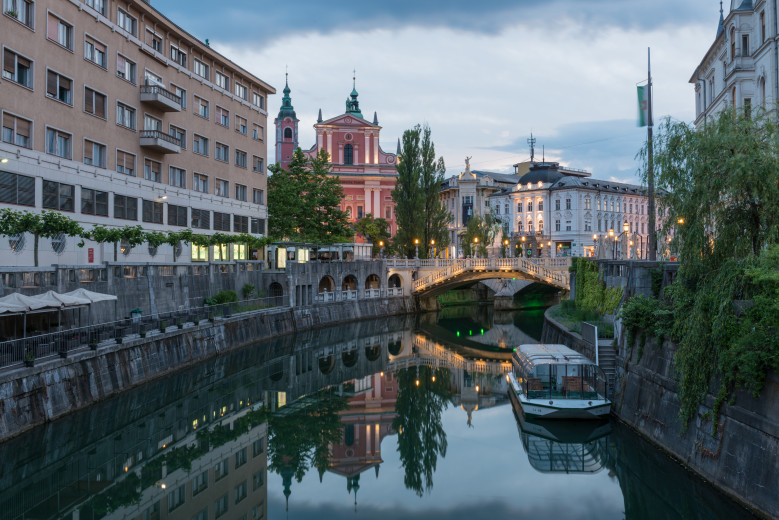Date: 4. October 2024
Time to read: 4 min
World Architecture Day, celebrated this year on 7 October, was established in 2005 by the International Association of Architects to celebrate the profession and its work in a broader social and cultural context. Architecture expresses how we see the world and how we see ourselves.
It is a discipline that oscillates between science and art, and its visual language appeals to both the connoisseur and the general public. It speaks analogue and is technologically advanced at the same time, thematising eternal questions in a new way.
-
 Between 1929 and 1932, Plečnik added two more pedestrian bridges to the central bridge, creating a unique architectural feature of Ljubljana. Photo: Dunja Wedam/Turizem Ljubljana
Between 1929 and 1932, Plečnik added two more pedestrian bridges to the central bridge, creating a unique architectural feature of Ljubljana. Photo: Dunja Wedam/Turizem Ljubljana
-
 Ljubljana City Hall. Photo: Andrej Tarfila/Turizem Ljubljana
Ljubljana City Hall. Photo: Andrej Tarfila/Turizem Ljubljana
-
 Robb's Fountain, or the Fountain of the Three Rivers of Kranj, is Ljubljana's most famous fountain with sculptures in white marble. Photo: Dunja Wedam/Turizem Ljubljana
Robb's Fountain, or the Fountain of the Three Rivers of Kranj, is Ljubljana's most famous fountain with sculptures in white marble. Photo: Dunja Wedam/Turizem Ljubljana
-
 The high-style monastic church has a strict Palladian interior and a Borromini-style sculptural façade. Photo: Dunja Wedam/Turizem Ljubljana
The high-style monastic church has a strict Palladian interior and a Borromini-style sculptural façade. Photo: Dunja Wedam/Turizem Ljubljana
-
 In accordance with his personal, deeply humane vision, the architect Jože Plečnik transformed the city in dialogue with older developments, while at the same time responding to the needs of modern 20th-century society. Photo: Luka Esenko/Turizem Ljubljana
In accordance with his personal, deeply humane vision, the architect Jože Plečnik transformed the city in dialogue with older developments, while at the same time responding to the needs of modern 20th-century society. Photo: Luka Esenko/Turizem Ljubljana
For a better and more beautiful world
Architecture is a part of art and culture that cannot be avoided or overlooked. It has an impact on the individual and on society. It is intertwined with politics, economics, psychology, sociology, to make the world a better and more beautiful place. Walk through Slovenia's historic towns and discover traces of the past, from antiquity and the Middle Ages to the bourgeois architecture of the 19th century.
Ancient streets and squares, impressive medieval buildings, castles and city walls capture the imagination of every visitor.
You may be drawn to the old townhouses, where you will find museums and galleries as well as boutique shops and hotels.
-
 Štatenberg Manor is a Baroque manor house near Makole, on the outskirts of Halos and above the Dravinja River. Photo: Jošt Gantar/slovenia.info
Štatenberg Manor is a Baroque manor house near Makole, on the outskirts of Halos and above the Dravinja River. Photo: Jošt Gantar/slovenia.info
-
 Stara Ljubljana is a district of Ljubljana, the capital of Slovenia, and is located in the Centre quarter below Grajski hill on both sides of the Ljubljanica River. Photo: Andrej Tarfila/slovenia.info
Stara Ljubljana is a district of Ljubljana, the capital of Slovenia, and is located in the Centre quarter below Grajski hill on both sides of the Ljubljanica River. Photo: Andrej Tarfila/slovenia.info
-
 Today, in the Renaissance castle, you can visit the exhibitions of the Idrija City Museum, which tell the half-millennium-long story of Idrija's history - the story of technical achievements and their links with Almadén in Spain, home to the world's largest mercury mine, the hard work of the miners, and the sophistication of Idrija's lace. Photo: Luka Kotnik/slovenia.info
Today, in the Renaissance castle, you can visit the exhibitions of the Idrija City Museum, which tell the half-millennium-long story of Idrija's history - the story of technical achievements and their links with Almadén in Spain, home to the world's largest mercury mine, the hard work of the miners, and the sophistication of Idrija's lace. Photo: Luka Kotnik/slovenia.info
-
 The romantic Snežnik Castle in the Notranjska region is one of two castles in Slovenia with preserved authentic interiors from the second half of the 19th century. Photo: Nina Kurnik/slovenia.info
The romantic Snežnik Castle in the Notranjska region is one of two castles in Slovenia with preserved authentic interiors from the second half of the 19th century. Photo: Nina Kurnik/slovenia.info
-
 Ljubljana's central market, located in the centre of Ljubljana, consists of Plečnik's market stalls with four arcades, a colonnaded shed and shops. Photo: Miran Kambič/slovenia.info
Ljubljana's central market, located in the centre of Ljubljana, consists of Plečnik's market stalls with four arcades, a colonnaded shed and shops. Photo: Miran Kambič/slovenia.info
Architecture and space - cultural assets
Are you more fascinated by modern architectural masterpieces than ancient buildings? Outstanding Slovenian architects have left their mark both in Slovenia and beyond its borders.
Discover the masterpieces of Jože Plečnik on a walking tour of Ljubljana, the outstanding works of Maks Fabiani, former advisor to the heir to the Austro-Hungarian throne, the great architectural names of the post-war era and modern architectural achievements.
Over the past nineteen years, Architects' Day has become an important event on the Slovenian architectural scene. Not only does it help to promote the role of the architect, landscape architect and spatial planner externally, but it also draws attention to the importance and role of quality architecture and space as a cultural asset, a national identity and a quality of life as a fundamental value.






